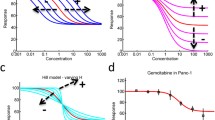Abstract
Dose–response curves of new substances in toxicology and related areas are commonly fitted using log-logistic functions. In more advanced studies, an additional interest is often how these substances will behave when applied in combination with a second substance. Here, an essential question for both design and analysis of these combination experiments is whether the resulting dose–response function will still be a member of the class of log-logistic functions, and, if so, what function parameters will result for the combined substances. Different scenarios might be considered in regard to whether a true interaction between the substances is expected, or whether the combination will simply be additive. In this paper, it is shown that the resulting function will in general not be a log-logistic function, but can be approximated very closely with one. Parameters for this approximation can be predicted from the parameters of both ingredients. Furthermore, some simple interaction structures can still be represented with a single log-logistic function. The approach can also be applied to Weibull-type dose–response functions, and similar results are obtained. Finally, the results were applied to a real data set obtained from cell culture experiments involving two cancer treatments, and the dose–response curve of a combination treatment was predicted from the properties of the singular substances.



Similar content being viewed by others
References
Bykov V, Zhang Q, Zhang M, Ceder S, Abrahmsen L, Wiman K (2016) Targeting of mutant p53 and the cellular redox balance by apr-246 as a strategy for efficient cancer therapy. Front Oncol 6:21. https://doi.org/10.3389/fonc.2016.00021
Chou T (2006) Theoretical basis, experimental design, and computerized simulation of synergism and antagonism in drug combination studies. Pharmacol Rev 58:621–681
Clothier R, Gomez-Lechon M, Honegger P, Kinsner-Ovaskainen A, Kopp-Schneider A (2013) Comparative analysis of eight cytotoxicity endpoints within the acutetox project. Toxicol In Vitro 27:1347–1356
Goutelle S, Maurin M, Rougier F, Barbaut X, Bourguignon L, Ducher M, Maire P (2008) The hill equation: a review of its capabilities in pharmacological modelling. Fundam Clin Pharmacol 22(6):633–648
Greco W, Bravo G, Pasons J (1995) The search for synergy: A critical review from a response surface perspective. Pharmacol Rev 47(2):331–385
He X, Wikstrand C, Friedman H, Bigner S, Pleasure S, Trojanowski J, Bigner D (1991) Differentiation characteristics of newly established medulloblastoma cell lines (d384 med, d425 med, and d458 med) and their transplantable xenografts. Lab Invest 64(4):833–843
Holland-Letz T, Kopp-Schneider A (2015) Optimal experimental designs for dose-response studies with continuous endpoints. Arch Toxicol 89(11):2059–68
Holland-Letz T, Kopp-Schneider A (2017) Optimal experimental designs for estimating the drug interaction index in toxicology. Comput Stat Data Anal. https://doi.org/10.1016/j.csda.2017.08.006
Lee J, Kong M, Ayers G, Lotan R (2007) Interaction index and different methods for determining drug interaction in combination therapy. J Biopharm Stat 17:461–480
Loewe S, Muischnek H (1926) Effect of combinations: mathematical basis of the problem. Arch Exp Pathol Pharmakol 114:313–326
MacDougall J (2006) Analysis of dose-response studies—Emax model. In: Ting N (ed) Dose finding in drug development. Springer, New York, pp 127–145
Ritz C (2010) Toward a unified approach to dose-response modeling in ecotoxicology. Environ Toxicol Chem 29(1):220–229
Ritz C, Streibig J (2014) From additivity to synergism—a modelling perspective. Synergy 1:22–29
Ritz C, Baty F, Streibig JC, Gerhard D (2015) Dose-response analysis using. PLOS One. http://journals.plos.org/plosone/article?id=10.1371/journal.pone.0146021. Accessed 29 Nov 2019
Vakil V, Trappe W (2019) Drug combinations: Mathematical modeling and networking methods. Phamaceutics. https://doi.org/10.3390/pharmaceutics11050208
Weimer M, Jiang X, Pontaa O, Stanzel S, Freyberger A, Kopp-Schneider A (2012) The impact of data transformations on concentration-response modeling. Toxicol Lett 213:292–298
Acknowledgements
The authors would like to thank Darell Doty Bigner for the friendly gift of the D425 Med cell line.
Author information
Authors and Affiliations
Corresponding author
Additional information
Publisher's Note
Springer Nature remains neutral with regard to jurisdictional claims in published maps and institutional affiliations.
Rights and permissions
About this article
Cite this article
Holland-Letz, T., Leibner, A. & Kopp-Schneider, A. Modeling dose–response functions for combination treatments with log-logistic or Weibull functions. Arch Toxicol 94, 197–204 (2020). https://doi.org/10.1007/s00204-019-02631-2
Received:
Accepted:
Published:
Issue Date:
DOI: https://doi.org/10.1007/s00204-019-02631-2




